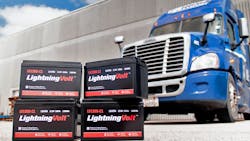Guest Blog: Save fuel with lithium APU batteries
Electric auxiliary power units (APUs) are designed to cut fuel costs and idle times, while increasing the comfort of a truck’s sleeper cab. However, most electric APUs are fitted with lead-acid or AGM batteries, causing limitations. Lead-acid batteries make effective starter batteries, providing short bursts of energy. They are less suited to deep-cycle applications like electric APUs, which need a steady, consistent current. By swapping electric APU batteries with Roadwarrior’s lithium upgrade, LightningVolt, fleets can see long-term savings, better fuel economy, and improved APU performance, the company said.
Cut down on idle time
To power hotel-load accessories without draining the starter batteries, long-haul truckers need to idle while parked. However, engine idling dramatically drives up fuel costs. The main engine is designed to pull the truck and chassis-mounted accessories, so it burns far more fuel per minute than needed to power electronics. In one hour, an idling truck can burn through a gallon (3.8 liters) of fuel. On average, every hour of idling can cost $4.00 USD or $5.32 CAD. This adds up quickly, with 10 hours of idling costing $40 USD or $53 CAD; over a year, with 250–300 nights on the road, this comes to $10,000 to $12,000 USD or $13,250 to $15,900 CAD.Electric APU idle reduction technology
To reduce air pollution, officials introduced limited-idle or no-idle regulations across much of North America, including loading zones and truck stops. This is good because a commercial truck’s HVAC system draws ambient air into the sleeper cab. If other trucks are idling nearby, the HVAC will draw exhaust emissions into the cab, disrupting the driver’s rest and overall health.
Modern trucks with emissions controls, built according to EPA regulations, aren’t designed for idling. Truck aftertreatment systems struggle with low-duty cycles, and idling is the lowest-duty cycle. Idling rapidly clogs a DPF, leading to unnecessary active and forced regens, and unscheduled downtime. Idling also decreases the gap between engine services. According to American Trucking Associations estimates, idling can cause twice the wear and damage to engine parts that normal driving causes.
Reduce unnecessary engine starts
A battery-powered idle reduction system like an electric APU allows for electronics, appliances, and HVAC systems to operate without idling. This is especially important during mid-summer and mid-winter when temperature extremes drive up fuel costs. However, electric APUs rarely last a full eight hours running a high load on AGM batteries.
By upgrading to high-quality lithium batteries, users can get more use from the auxiliary system and run higher-draw appliances. LightningVolt offers double the run-time between charges and twice the usable power of an AGM battery, according to the company. This means users don’t have to start their engine to recharge during long breaks or overnight, saving fuel. With more charge cycles, LightningVolt also lasts 10-times longer, meaning one LightningVolt battery can save users from replacing 10 AGM batteries, the company said.
For added value, Roadwarrior’s LightningVolt batteries include a management system to extend their working life and optimize performance. The in-built safety feature protects against overcharging and overcurrent, and lets the batteries reach maximum discharge depth repeatedly without being damaged.
Maintain performance levels during temperature extremes
Roadwarrior builds lithium LightningVolt batteries in Canada and designs them to withstand the extremes of Canadian weather and terrain. They maintain considerably higher rates of charge than traditional batteries, even below freezing, the company said. This cuts fuel costs because the batteries run in extreme cold without the engine on. Users can charge them in temperatures as low as -4F, but charging speeds decrease below freezing to protect the batteries. After 15-30 minutes of running a moderate load, the batteries will warm up enough to charge at normal rates. To increase runtime or boost voltage for higher-draw appliances, users can also connect LightningVolt batteries in parallel or up to four in series.
Information provided by: Roadwarrior

